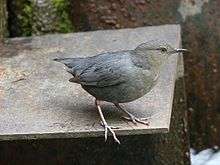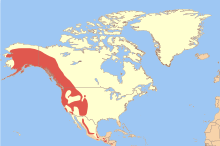American dipper
| American dipper | |
|---|---|
 | |
| Scientific classification | |
| Kingdom: | Animalia |
| Phylum: | Chordata |
| Class: | Aves |
| Order: | Passeriformes |
| Family: | Cinclidae |
| Genus: | Cinclus |
| Species: | C. mexicanus |
| Binomial name | |
| Cinclus mexicanus Swainson, 1827 | |
 | |


The American dipper (Cinclus mexicanus), also known as a water ouzel, is a stocky dark grey bird with a head sometimes tinged with brown, and white feathers on the eyelids that cause the eyes to flash white as the bird blinks. It is 16.5 cm long and weighs on average 46 g. It has long legs, and bobs its whole body up and down during pauses as it feeds on the bottom of fast-moving, rocky streams. It inhabits the mountainous regions of Central America and western North America from Panama to Alaska.
This species, like other dippers, is equipped with an extra eyelid called a "nictitating membrane" that allows it to see underwater, and scales that close its nostrils when submerged. Dippers also produce more oil than most birds, which may help keep them warmer when seeking food underwater.
In most of its habits, it closely resembles its European counterpart, the white-throated dipper, Cinclus cinclus, which is also sometimes known as a Water Ouzel. It feeds on aquatic insects and their larvae, including dragonfly nymphs, small crayfish, and caddisfly larvae. It may also take tiny fish or tadpoles.

The song consists of high whistles or trills peee peee pijur pijur repeated a few times. Both sexes of this bird sing year round. It defends a linear territory along streams. Its habit of diving underwater in search of food can infrequently make it the prey of large salmonids like bull or Dolly Varden trout.[2]
The American dipper's nest is a globe-shaped structure with a side entrance, close to water, on a rock ledge, river bank, behind a waterfall or under a bridge. The normal clutch is 2-4 white eggs, incubated solely by the female, which hatch after about 15–17 days, with another 20–25 days to fledging. The male helps to feed the young.
It is usually a permanent resident, moving slightly south or to lower elevations if necessary to find food or unfrozen water. The presence of this indicator species shows good water quality; it has vanished from some locations due to pollution or increased silt load in streams.
References
- ↑ BirdLife International (2012). "Cinclus mexicanus". IUCN Red List of Threatened Species. Version 2013.2. International Union for Conservation of Nature. Retrieved 26 November 2013.
- ↑ Elliott, Charles L.; Peck, Steve (December 1980). "Dipper swallowed by trout" (PDF). Wilson Bulletin. 92 (4): 524.
- Erlich et al. The Birder's Handbook
- Stiles and Skutch, A guide to the birds of Costa Rica ISBN 0-8014-9600-4
External links
| Wikimedia Commons has media related to Cinclus mexicanus. |
- American Dipper - Cinclus mexicanus - USGS Patuxent Bird Identification InfoCenter
- American Dipper Species Account - Cornell Lab of Ornithology
- Stamps for United States
- The Dipper - Plain, yes, but not so ordinary
- American Dipper photo gallery VIREO
- Short radio episode The Water-Ouzel, from The Mountains of California, by John Muir 1894. California Legacy Project.
- The American Dipper and Biodiversity Conservation Alliance
